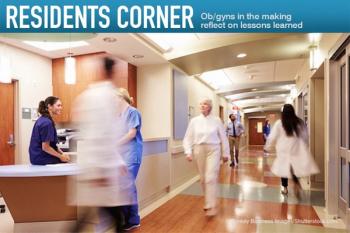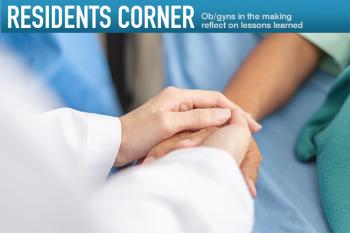
- Vol 64 No 05
- Volume 64
- Issue 05
Why I chose a MIGS fellowship
The choice to pursue a fellowship isn’t always straightforward, but one resident explains why she is choosing to follow her passion.
It’s honestly just a waste of time.”
“Why would you do a fellowship for something that you already know how to do?”
“MIGS isn’t even accredited.”
My chiefs and attendings read my mind when I was wrestling with the idea of applying for a fellowship in minimally invasive gynecology (MIGS) as a second-year resident.
I’ve loved surgery since medical school, so I was excited about my first surgical cases as an intern. I anticipated a steep learning curve, but by the end of the year, I felt like I’d barely taken a step. Much of the surgical teaching during my residency, as in most high-volume programs, is provided by private attendings. Skill levels vary, which I think is largely a product of the ob/gyn educational system. In most residencies, a great deal of time is spent on obstetrics, outpatient clinic, or night float coverage. We spend barely a year dedicated to gynecologic surgery. Contrast that with general surgery residents, who spend 5 years training in the operating room!
Now in my fourth year, I feel comfortable leading straightforward cases, but there’s no way I’m ready to tackle complex endometriosis or gigantic fibroid uteruses. Neither are most other ob/gyns straight out of training, and it’s the reason in-residency tracking and generalist fellowships are gaining traction.
On the other hand, watching surgical subspecialists operate is amazing. The way they navigate distorted anatomy, identify tissue planes, and troubleshoot unexpected challenges is beautiful. I want to grow up to be capable of that. But gynecologic oncology and urogynecology were not for me, and an unaccredited fellowship in MIGS seemed risky. I could graduate from residency and go directly into practice making $200,000+ a year. Or I could continue with my training making a PGY-5 salary, delaying financial stability for another 2 years.
AAGL established the first MIGS fellowship in 2001, with just seven spots and now there are 48 programs. In 2018, MIGS was the most competitive fellowship, with 1.7 applicants per position (compared to 1.4 applicants per position in gynecologic oncology, historically the most competitive fellowship).1 In April, The American Board of Medical Specialties approved the American Board of Obstetrics and Gynecology's application for a Focused Practice Designation in Minimally Invasive Gynecologic Surgery. This step towards recognizing those that have significant experience in gynecologic surgery reflects what may be a response to an anticipated shift in the field from maintaining full ob/gyn practices to specializing in either obstetrics or gynecology. It is conceivable that eventually, physicians without fellowship training will not perform any gynecologic surgery. That would be a major change, but I think we all can agree that patients deserve the best chance at a good outcome, and on that point, the data favor high-volume surgeons.2
With the advent of more medical treatment options for fibroids, heavy menstrual bleeding, and pelvic pain, the volume of gynecologic surgery across the country has fallen.3 Therefore, by default, more surgeons are becoming low-volume surgeons.4 So, even if I planned to hone my surgical skills in practice with the aid of a senior partner, the opportunity to progress might not really exist. If you operate once a month, how will you maintain your skills? Maybe it’s not absolutely necessary to do a fellowship, but there is no denying that doing three to five surgical cases a day, 5 days a week for 2 years, will accelerate your skills.
In the end, I decided to apply for the MIGS fellowship because I want to be the best surgeon I can be. I want my patients to get the best surgery for them. I don’t want to take shortcuts for my convenience or because of my skill level. I don’t want to fulgurate endometriosis and call it a day. I don’t want to do a supracervical hysterectomy because I’m afraid of the ureter. I don’t want to leave the fallopian tubes behind on a vaginal hysterectomy. I want my cases to be elegant, beautiful, purposeful.
Attention residents!
Are you a current intern or resident and interested in writing about your experiences?
Email COGEditorial@mmhgroup.com to learn more about becoming a resident blogger.
CORRECTION: Dr. Misal originally stated that "In April, the American Board of Medical Specialties approved AAGL’s application for a focused practice designation in minimally invasive gynecology, which would require those seeking such a designation to complete a minimum of 100 MIGS procedures in patients with benign and complex gynecologic conditions." This was not AAGL's application. This is the American Board of OBstetrics and Gynecology's program. Contemporary OB/GYN apologizes for the error.
References:
- Vargas MV, Milad MP. Matching Trends for the Fellowship in Minimally Invasive Gynecologic Surgery Since Participation in the National Residency Match Program. J Minim Invas Gyn. 2018;25(6):1060-1064.
- Mowat A, Maher C, Ballard E. Surgical outcomes for low-volume vs high-volume surgeons in gynecology surgery: a systematic review and meta-analysis. Am J Obstet Gynecol. 2016;215(1):21-33.
- Morgan DM, Kamdar NS, Swenson CW, Kobernik EK, Sammarco AG, Nallamothu B. Nationwide trends in the utilization of and payments for hysterectomy in the United States among commercially insured women. Am J Obstet Gynecol. 2018;218(4):425 e421-425 e418.
- Walter A. Every woman deserves a high-volume gynecologic surgeon. Am J Obstet Gynecol. 2017;216(2):139 e131-139 e133.
Articles in this issue
over 6 years ago
Reproductive risks of advanced paternal ageover 6 years ago
Counseling on complex contraception dilemmas: Case 2over 6 years ago
Congenital syphilis makes a comebackover 6 years ago
Redefining postpartum careover 6 years ago
Was this rectocele repair necessary?over 6 years ago
Drug for postmenopausal osteoporosis gets nod from FDAover 6 years ago
Experimental vaccine for HPV-associated CIN2/3over 6 years ago
Should ob/gyns use metformin to treat pregnant women with PCOS?over 6 years ago
FDA proposes updates to mammography regulationsNewsletter
Get the latest clinical updates, case studies, and expert commentary in obstetric and gynecologic care. Sign up now to stay informed.











